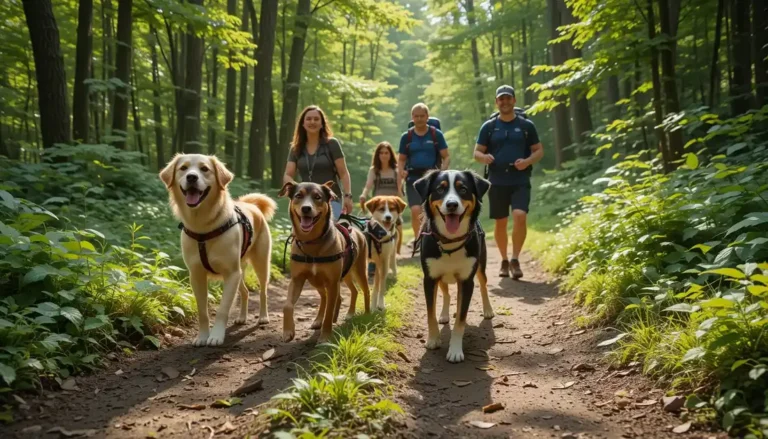The best dog breeds for hiking and outdoor adventures are those with high stamina, sturdy builds, and weather‑ready coats. Breeds such as the Siberian Husky, Australian Shepherd, and Border Collie consistently excel on trails ranging from rugged mountain paths to sunny coastal walks.
These energetic canines combine endurance, intelligence, and a love of exploration, making every trek a shared adventure.
Below you’ll discover how to match your trail goals with the perfect four‑legged partner, plus training tips, gear checklists, health safeguards, and seasonal hacks to keep both of you thriving on the trail.
What Makes a Dog Ideal for Hiking and Outdoor Adventures?
Choosing the best dog breeds for hiking and outdoor pursuits begins with evaluating three core pillars: physical capability, temperament, and health resilience.
A dog that meets these criteria will enjoy the experience as much as you do and stay safe on variable terrain.
Physical Attributes
- Stamina & Cardio – Long‑distance trails demand a heart that can keep a steady pace for hours. Breeds like the Siberian Husky and Border Collie excel here.
- Size & Build – Larger dogs (e.g., Bernese Mountain Dog) provide power on steep climbs, while compact breeds (e.g., Jack Russell Terrier) weave through dense underbrush with ease.
- Coat Type – Double coats protect against cold and brush; short, water‑repellent coats keep a dog comfortable in heat and wet conditions.
Temperament
- Sociable Nature – Friendly, well‑socialized dogs such as Labrador Retrievers and Golden Retrievers reduce tension when you encounter fellow hikers or wildlife.
- Obedient & Trainable – High‑intelligence breeds (Australian Cattle Dog, Vizsla) learn recall and “leave‑it” commands quickly, essential for off‑leash safety.
- Adventure‑Driven Instinct – Dogs bred for work—Huskies for sledding, Cattle Dogs for herding—have an innate drive to explore and persevere.
Health Considerations
- Joint Health – Large breeds need joint support to avoid hip dysplasia; smaller, agile breeds typically have robust joints suited for rocky terrain.
- Climate Tolerance – Double‑coated breeds thrive in cold climates but can overheat in summer; short‑coated breeds handle heat better but need protection from cold.
- Energy Levels – High‑energy dogs demand structured activity; without it, they may develop destructive habits that interfere with your hikes.
Training Needs
- Recall & Leash Manners – Reliable recall prevents dangerous chases. Breeds such as German Shepherds and Labradors respond well to consistent obedience drills.
- Wildlife Awareness – Dogs with a strong prey drive (e.g., German Shorthaired Pointers) need “leave‑it” training to ignore squirrels or birds.
- Environmental Adaptability – Gradual exposure to water crossings, steep inclines, and varying weather builds confidence in breeds like the Siberian Husky and Bernese Mountain Dog.

Key Takeaway – The best dog breeds for hiking and outdoor adventures balance physical resilience, mental sharpness, and a love of exploration, allowing you both to enjoy the trail safely and happily.
Top 12 Best Dog Breeds for Hiking and Outdoor Adventures
Below is a quick‑reference guide to the most versatile trail companions.
Each breed’s standout trait is highlighted so you can match it to your preferred activity style.
| Rank | Breed | Ideal Terrain | Key Strength | Climate Fit |
|---|---|---|---|---|
| 1 | Siberian Husky | Long distance, snowy paths | Endurance, pull power | Cold & moderate |
| 2 | Australian Shepherd | Varied, rugged | Agility, intelligence | Mild to cool |
| 3 | Border Collie | Fast‑paced, technical | Speed, focus | Temperate |
| 4 | German Shorthaired Pointer | Forest, field | Stamina, scent tracking | Warm |
| 5 | Bernese Mountain Dog | Alpine, heavy load | Strength, calm | Cold |
| 6 | Vizsla | Hilly, mixed | Speed, sociability | Warm |
| 7 | Labrador Retriever | Water, family hikes | Swimming, gentleness | Moderate |
| 8 | Golden Retriever | Gentle slopes, campsites | Patience, friendliness | Moderate |
| 9 | Rhodesian Ridgeback | Rocky, dry | Endurance, poise | Hot & dry |
| 10 | Jack Russell Terrier | Short, technical | Tenacity, agility | All |
| 11 | Nova Scotia Duck Tolling Retriever | Stream, coastal | Swimming, enthusiasm | Cool to mild |
| 12 | Miniature Pinscher | Urban trails, quick trips | Alertness, light load | Moderate |
How to Choose the Right Breed for Your Adventures
- Identify your primary terrain (mountain, forest, water, urban).
- Match the breed’s physical strengths to that terrain.
- Consider climate – double‑coated breeds love snow, short coats love heat.
- Assess your lifestyle – can you provide daily high‑energy outlets?
Breed‑by‑Breed Deep Dive
Each of the top twelve breeds gets a focused profile, covering origins, trail suitability, health notes, and gear tips.
Siberian Husky
- Origins: Siberian sled dogs bred to pull loads over 1,000‑mile treks.
- Stamina: Can cover 50+ miles daily at a moderate pace.
- Coat: Thick double coat; excels in cold, needs cooling gear in summer.
- Temperament: Friendly, independent; strong prey drive.
- Ideal Trail: Snowy mountain passes, long‑distance treks, cooler climates.
- Health Alerts: Prone to hip dysplasia, eye disorders (e.g., cataracts).
- Gear Tip: Use a breathable, lightweight vest in warm weather; consider booties on hot pavement to protect paws.
Australian Shepherd
- Origins: Australian farms, later popularized in the U.S. for herding.
- Stamina: High‑energy, thrives on 3‑hour hikes with variable terrain.
- Coat: Medium‑length double coat; water‑repellent, good for moderate weather.
- Temperament: Intelligent, eager to please, quick learner.
- Ideal Trail: Hilly countryside, forested paths, moderate elevations.
- Health Alerts: Hip dysplasia, progressive retinal atrophy (PRA).
- Gear Tip: Front‑clip harness to curb pulling; pack a lightweight dog pack (10‑15% body weight) for treats and water.
Border Collie
- Origins: British herding dogs are renowned for problem‑solving.
- Stamina: Built for endurance work; can sprint and maintain pace.
- Coat: Medium‑length, weather‑resistant, sheds heavily seasonally.
- Temperament: Highly trainable, needs mental stimulation.
- Ideal Trail: Fast‑paced, technical terrain; good for runners who enjoy agility.
- Health Alerts: Epilepsy, collie eye anomaly (CEA).
- Gear Tip: Use a sturdy, padded collar; bring puzzle toys to keep the mind engaged on rest stops.
German Shorthaired Pointer
- Origins: German hunting dog developed for versatile field work.
- Stamina: Excellent aerobic capacity, covers long distances effortlessly.
- Coat: Short, dense, water‑resistant; tolerates both heat and rain.
- Temperament: Friendly, eager, strong scent drive.
- Ideal Trail: Dense forests, wetlands, field hunts.
- Health Alerts: Hip dysplasia, osteochondritis dissecans (OCD).
- Gear Tip: Attach a quick‑release leash with a sturdy handle; consider a floating dog harness for water crossings.
Bernese Mountain Dog
- Origins: Swiss farm dogs used for draft work and guarding.
- Stamina: Moderate; excels on longer, slower hikes with ample rest.
- Coat: Thick, tri‑colored double coat; superb insulation.
- Temperament: Gentle, calm, great with families.
- Ideal Trail: Alpine meadows, snowy paths, cooler mountain regions.
- Health Alerts: High risk of hip and elbow dysplasia, bloat (gastric dilatation‑volvulus).
- Gear Tip: Use a harness with extra padding for joint support; avoid steep, fast‑descent trails to protect your hips.
Vizsla
- Origins: Hungarian pointer bred to work in fields and forests.
- Stamina: High‑energy, can sustain fast pacing over long distances.
- Coat: Short, smooth, low‑maintenance; prefers milder climates.
- Temperament: Affectionate, alert, strong bond with owner.
- Ideal Trail: Rolling hills, mixed terrain, warm weather hikes.
- Health Alerts: Hip dysplasia, epilepsy.
- Gear Tip: Carry a collapsible water bowl; use a cooling vest during hot midday treks.
Labrador Retriever
- Origins: Fishermen’s helper from Newfoundland, later a gun dog.
- Stamina: Robust, loves water and moderate hikes.
- Coat: Short, water‑repellent double coat; perfect for wet conditions.
- Temperament: Friendly, obedient, excellent with kids.
- Ideal Trail: Lakeside paths, beach walks, family hikes.
- Health Alerts: Hip/elbow dysplasia, progressive retinal atrophy.
- Gear Tip: Waterproof harness and a life jacket for water activities; keep a large, collapsible bowl for frequent water breaks.
Golden Retriever
- Origins: Scottish hunting companion for retrieving waterfowl.
- Stamina: Moderate‑high; comfortable on longer, leisurely walks.
- Coat: Long, dense, water‑repellent; requires regular grooming.
- Temperament: Gentle, patient, good with children.
- Ideal Trail: Gentle slopes, forest clearings, family outings.
- Health Alerts: Hip dysplasia, heart disease (subvalvular aortic stenosis).
- Gear Tip: Use a harness with a handle for quick control; carry a brush to manage shedding after muddy hikes.
Rhodesian Ridgeback
- Origins: African hunting dog used to track lions.
- Stamina: High; built for hot, dry climates and rugged terrain.
- Coat: Short, tight, low‑maintenance; tolerates heat well.
- Temperament: Loyal, protective, strong focus.
- Ideal Trail: Rocky deserts, dry canyon paths, high‑altitude trails with warm weather.
- Health Alerts: Hip dysplasia, dermoid sinus.
- Gear Tip: Sun protection (e.g., a lightweight dog shirt) in strong sunlight; carry a wide‑brimmed hat for yourself to shade the dog’s face.
Jack Russell Terrier
- Origins: English fox hunting companion, now a sporty terrier.
- Stamina: Small but explosive; loves short bursts of high energy.
- Coat: Smooth, rough, or broken; short enough for warm weather.
- Temperament: Fearless, curious, highly trainable.
- Ideal Trail: Short, technical hikes with lots of digging and exploration.
- Health Alerts: Patellar luxation, eye issues (e.g., cataracts).
- Gear Tip: Tiny dog backpack (up to 15% body weight) for water bottle; protective booties on rocky terrain.
Nova Scotia Duck Tolling Retriever
- Origins: Canadian breed developed to “toll” (lure) waterfowl.
- Stamina: Moderate; loves swimming and brisk walks.
- Coat: Medium‑length, water‑repellent, red‑gold hue.
- Temperament: Energetic, intelligent, good with families.
- Ideal Trail: Streamside paths, shoreline hikes, cool water play.
- Health Alerts: Hip dysplasia, progressive retinal atrophy.
- Gear Tip: Harness with a swimming vest for cold water; quick‑dry towel for after swims.
Miniature Pinscher
- Origins: German “king of toys,” bred for rat hunting.
- Stamina: Sprightly, enjoys short, lively hikes.
- Coat: Short, smooth, low‑shedding.
- Temperament: Bold, alert, quick learner.
- Ideal Trail: Urban parks, short nature loops, easy terrain.
- Health Alerts: Patellar luxation, heart murmurs.
- Gear Tip: Lightweight harness with a reflective strip for early morning or night hikes; a small water bottle attachment.

Adoption vs. Buying: Finding the Perfect Trail Partner
Whether you adopt or purchase a puppy, the goal is the same—to secure a dog that thrives on the trail. Below are practical points to weigh when deciding which path to take.
Pros of Adoption
- Cost‑Effective – Fees typically range $50–$300, often covering initial vaccinations and spay/neuter.
- Mixed‑Breed Hybrid Vigor – Genetic diversity can reduce the likelihood of inherited disorders such as hip dysplasia.
- Rescue Availability – Shelters frequently have high‑energy dogs eager for outdoor work; many are already partially trained.
Cons of Adoption
- Uncertain Lineage – Without pedigree papers, it can be harder to predict exact energy levels or endurance.
- Potential Behavioral Gaps – Some rescues may have trauma or lack exposure to outdoor settings, requiring extra socialization.
Pros of Buying (Reputable Breeder)
- Predictable Traits – Breeders provide health clearances, temperament evaluations, and lineage documentation (e.g., a Husky’s proven sled‑pulling stamina).
- Health Guarantees – Many breeders offer warranties for hereditary conditions, giving peace of mind for high‑impact activities.
Cons of Buying
- Higher Financial Outlay – Prices range $800–$2,500+, especially for champion lines.
- Risk of Puppy Mills – Unethical breeders may produce dogs with poor socialization, health issues, or unsuitable temperaments for hiking.
Assessing a Rescue Dog for Trail Use
- Energy Test – Observe the dog during a 20‑minute walk; does it maintain interest without lagging?
- Basic Obedience – Ensure the dog reliably follows “sit,” “stay,” and “come.”
- Joint Evaluation – Look for limping, reluctance to climb stairs, or uneven gait.
- Health Records – Verify vaccinations, deworming, and recent vet exams.
- Age Fit – Puppies need 12–18 months to mature before tackling strenuous hikes; adult dogs often are “trail‑ready.”
Bottom Line – The best dog breeds for hiking and outdoor fun can be found in both shelters and reputable breeders. Focus on physical resilience, trainability, and a history of activity, and you’ll secure a reliable companion regardless of source.
Training Your Dog for Hiking and Outdoor Adventures
A well‑trained dog is a safe dog. Training for the trail builds obedience, confidence, and the ability to respond to unexpected wildlife or terrain challenges.
Core Obedience Commands
| Command | Why It Matters on the Trail | Training Tips |
|---|---|---|
| Sit/Stay | Prevents sudden lunges toward wildlife or hikers. | Practice in low‑distraction areas; gradually add distance and duration. |
| Come (Recall) | Essential for off‑leash safety. | Use high‑value treats; start with short distance, increase to longer, more distracting environments. |
| Heel/Loose‑Leash Walking | Keeps the dog close, reduces pulling on uneven ground. | Walk with a front‑clip harness; reward every few steps for staying beside you. |
| Leave It | Stops chasing squirrels, birds, or food on the trail. | Begin with treats on a flat surface, progress to outdoor distractions. |
| Wait at Trail Intersections | Prevents the dog from darting into traffic or dangerous paths. | Use a “wait” cue before turning; reward patience before moving forward. |
Trail‑Specific Training Steps
- Gradual Distraction Exposure – Start on a quiet park path, slowly introduce busier trails, then add wildlife sounds (recordings or live sightings).
- Off‑Leash Practice in Enclosed Areas – Use a long line (30 ft) to allow freedom while retaining recall control.
- Paw Conditioning – Walk the dog on varied surfaces (grass, gravel, sand) to build paw strength; check pads after each session.
- Water Acclimation – Introduce shallow water at home; encourage swimming with positive reinforcement.
- Pack Carry Training – Let the dog wear a lightweight backpack indoors, rewarding calm behavior.
Breed‑Specific Challenges & Solutions
| Breed | Typical Challenge | Training Solution |
|---|---|---|
| Siberian Husky | Strong independent streak; may ignore commands. | Use firm, consistent cues; incorporate games that make obedience rewarding. |
| Border Collie | High mental energy leading to distraction. | Provide puzzle toys on breaks; include “focus” drills (“watch me”). |
| Jack Russell Terrier | Impulsive chase response. | Emphasize “leave it” and “wait” with quick, positive corrections. |
| Bernese Mountain Dog | Slower learning speed, joint concerns. | Use low‑impact training (e.g., sit‑stay on carpet); avoid high‑jump commands. |
| Vizsla | Sensitivity to harsh tones. | Use gentle, enthusiastic voice; avoid punishment. |
Key Takeaway – Consistency, positive reinforcement, and progressive exposure are the pillars of trail‑ready training for any of the best dog breeds for hiking and outdoor pursuits.

Essential Gear for Hiking with Your Dog
The right equipment protects your companion, enhances comfort, and keeps you both prepared for emergencies. Below is a gear checklist organized by function.
Leashes, Collars, and Harnesses
- Front‑Clip Harness – Ideal for strong pullers (e.g., Huskies, Australian Shepherds) to redirect momentum.
- Hands‑Free Leash – Perfect for trail runners or hikers needing two free hands; attach to a waist belt.
- Standard Leash (4–6 ft) – Best for crowded trails where close control is needed.
- Breakaway Collar – Useful for hot climates; releases under pressure to prevent choking.
Paw Protection
- Booties – Provide grip on icy or rocky ground; choose breathable meshes for warm weather.
- Paw Balm – Apply before and after hikes to soothe cracks and protect from de‑icing chemicals.
Dog Backpacks
- Weight Limit – 10‑25 % of body weight; larger breeds can handle more.
- Features – Adjustable straps, water‑bottle holder, reflective strips for low‑light visibility.
Hydration Solutions
- Collapsible Silicone Bowls – Lightweight, easy to clean.
- Portable Water Bottles with Attachments – Clip onto pack; some have built‑in drinking spouts.
- Electrolyte Powder – Add to water for breeds with high energy output (e.g., Border Collies).
Weather‑Specific Apparel
- Cooling Vest – Evaporative fabric for double‑coated breeds in summer (e.g., Huskies).
- Insulated Jacket – Waterproof, wind‑proof for cold climates; essential for short coats (e.g., Vizsla).
- Life Jacket – Mandatory for water‑based hikes; fits snugly and has a handle for rescue.
First‑Aid Essentials
- Canine‑Specific Kit – Include antiseptic wipes, non‑stick gauze, tweezers (for ticks), and a small syringe for administering oral electrolytes.
- Medication – If your dog has a chronic condition (e.g., heart meds), pack a spare dose.
- Emergency Contact Card – List your vet, nearest 24‑hour animal hospital, and your dog’s microchip number.
Optional Extras
- LED Collar or Vest – Increases visibility during dawn/dusk hikes.
- Portable Poop Bags – Pack at least one per mile; practice “Leave No Trace” ethics.
- Travel Blanket – Provides a clean surface for rest stops on wet ground.
Gear Summary – Each item should be chosen based on breed size, coat type, and trail conditions, ensuring the best dog breeds for hiking and outdoor journeys stay safe, comfortable, and capable.
Health, Safety, and First‑Aid on the Trail
Proactive health management reduces the risk of injuries and emergencies while you explore.
Pre‑Hike Health Checks
- Weight & Body Condition – Aim for a visible waist and palpable ribs without excess fat. Overweight dogs strain joints on steep climbs.
- Joint Mobility – Gently flex hips and knees; watch for stiffness or reluctance to climb stairs.
- Coat & Skin – Brush out tangles, especially in double‑coated breeds; check for ticks, burrs, or hot spots.
- Hydration Status – Ensure gums are pink and moist; dry gums signal dehydration.
Injury Prevention
| Issue | Prevention Strategy | Breed‑Specific Note |
|---|---|---|
| Joint Strain | Shorten ascent angles, use a harness with padded support. | Large breeds (Bernese) need extra joint supplements. |
| Overheating | Offer water every 20–30 min; use cooling vests for dense coats. | Huskies and other double‑coated dogs are particularly vulnerable in heat. |
| Paw Abrasions | Apply booties on rocky trails; use paw balm before and after. | Terriers and small breeds with thin pads benefit most. |
| Heatstroke | Move to shade, apply cool water to neck and paws, sip water slowly. | Immediate vet care if symptoms persist (vomiting, collapse). |
| Tick‑Born Illnesses | Perform daily tick checks; use vet‑approved repellents. | All breeds, especially those with dense hair, need vigilant checks. |
First‑Aid Basics
- Control Bleeding – Apply pressure with a sterile gauze; use a non‑stick wrap if needed.
- Treat Wounds – Clean with saline, apply antiseptic ointment, and cover with a bandage.
- Address Burns – Rinse with cool (not cold) water; avoid ice. Seek veterinary care for severe burns.
- Soothe Insect Stings – Remove the stinger, apply a cold compress, and monitor for allergic reactions.
- Handle Splinters/Thorn Injuries – Use tweezers; if deep, secure the area and seek professional help.
Emergency Plan – Know the nearest veterinary emergency clinic; carry a GPS device or an offline map with marked animal hospitals.

Seasonal Trail Tips for Dogs
Weather changes demand adjustments to your hiking routine, gear, and care.
Summer
- Heat Management – Start hikes early (sunrise) or late (sunset). Provide shade every 30 min.
- Hydration – Offer water or electrolyte‑enhanced fluids frequently; carry 1 oz per pound of body weight per hour.
- Cooling Gear – Use evaporative vests for double‑coated breeds; keep booties off to prevent overheating of paws.
- Sun Protection – Apply dog‑safe sunscreen on ears, nose, and belly for light‑pigmented breeds.
Winter
- Insulation – Dress short‑haired dogs (e.g., Vizsla) in fleece jackets; double‑coat breeds may need a wind‑proof layer only.
- Paw Care – Use paw balm and waterproof booties to protect against ice, salt, and frostbite.
- Shorten Duration – Limit hikes to 1–2 hours for small or thin‑coated breeds; monitor for shivering.
- Post‑Hike Warm‑Up – Dry fur thoroughly, wipe salt off paws, and offer a warm, water‑rich meal.
Spring / Fall
- Tick & Flea Prevention – Apply monthly preventatives; inspect fur and skin after each hike.
- Allergy Awareness – Watch for excessive scratching or sneezing; consider hypoallergenic shampoos for breeds with sensitive skin.
- Mud & Debris – Clean paws and coat before entering the car or home to prevent infections.
- Layering – Dress dogs in removable layers; temperatures swing widely during these transitional seasons.
Seasonal Summary – Adjust your pace, gear, and care routine to match the climate, ensuring the best dog breeds for hiking and outdoor activities stay comfortable year‑round.
Nutrition and Hydration for Trail Dogs
Fueling your canine companion is as crucial as your nutrition. A proper diet supports stamina, joint health, and recovery.
Pre‑Hike Feeding
- Timing – Feed a balanced meal 2–3 hours before the hike to allow digestion.
- Portion Control – Reduce regular kibble by 10‑15 % on active days to prevent sluggishness.
- Energy‑Rich Add‑Ons – Mix in a spoonful of canned pumpkin or a small amount of plain yogurt for additional calories and digestive aid.
On‑Trail Snacks
- High‑Protein Treats – Freeze‑dried chicken strips or low‑fat jerky; provide 1–2 oz per hour for high‑energy breeds.
- Electrolyte Supplements – Add a pinch of veterinary‑approved electrolyte powder to water for breeds like Border Collies that sweat heavily.
- Portable Food Pouches – Lightweight, resealable bags prevent crushing kibble; ideal for dog backpacks.
Post‑Hike Recovery
- Rehydration – Offer water with a dash of low‑sodium broth to entice drinking.
- Protein Boost – Serve a small serving of cooked lean meat (chicken, turkey) mixed with rice for joint repair.
- Joint Supplements – Glucosamine‑chondroitin blends benefit large, load‑bearing breeds (Bernese, Labrador).
Special Dietary Considerations
| Breed | Common Nutritional Need | Recommended Action |
|---|---|---|
| Siberian Husky | High caloric burn; prone to weight loss on hikes | Joint stress, prone to hip dysplasia |
| Bernese Mountain Dog | Joint stress; prone to hip dysplasia | Add an extra fat source (e.g., fish oil) to meals. |
| Jack Russell Terrier | Small stomach; quick energy spikes | Feed multiple small meals throughout the day instead of one large one. |
| Vizsla | Sensitive skin; prone to allergies | Include glucosamine supplements and maintain a lean body condition. |
| Golden Retriever | Prone to obesity | Monitor calories; limit treats; maintain regular exercise. |
Bottom Line – Consistent, breed‑appropriate nutrition fuels the best dog breeds for hiking and outdoor adventures, bolsters recovery, and helps avoid health setbacks.
Dog Trail Etiquette and Responsible Hiking
Respecting fellow hikers, wildlife, and the environment ensures enjoyable outings for everyone.
- Leash Laws – Keep your dog on a leash where required; even off‑leash, maintain a reliable recall.
- Leave No Trace – Pack out all waste; bring biodegradable poop bags and dispose of them in designated bins.
- Wildlife Respect – Maintain a safe distance; use the “leave it” command to deter chasing.
- Yield to Others – Step aside if the trail narrows; allow other hikers and dogs to pass safely.
- Noise Control – Limit excessive barking; use a gentle voice command to quiet the dog if needed.
- Trail Cleanliness – Brush off mud and debris before entering vehicles or campgrounds.
- Identify Your Dog – Ensure tags, microchip, and a recent photo are up‑to‑date in case you get separated.
By following these guidelines, you’ll keep the trails welcoming for both humans and canines, reinforcing the reputation of the best dog breeds for hiking and outdoor fun as responsible companions.
FAQs
Which breed is the best all-around hiking dog?
Border Collies, Australian Shepherds, and Siberian Huskies are top all-around choices because they combine stamina, intelligence, and a love for varied terrain.
Can I take a puppy on a long hike?
Puppies should wait until they’re at least 12–18 months old (larger breeds even longer) to avoid stress on developing joints and to ensure proper training.
How much weight can a dog safely carry?
A dog backpack should never exceed 10–25 % of the dog’s body weight; larger, sturdy breeds can handle the higher end of that range.
What’s the best way to prevent my dog’s paws from getting injured?
Use booties on rough terrain, apply paw balm before and after hikes, and regularly inspect pads for cuts or abrasions.
Are there specific health checks I should do before a multi‑day trek?
Yes—verify up‑to‑date vaccinations, conduct a joint and gait assessment, and confirm the dog is at a healthy weight and fully hydrated.
Conclusion
Finding the best dog breeds for hiking and outdoor adventures means matching a breed’s stamina, coat, and temperament to your favorite trails and climate.
Whether you adopt a spirited rescue or select a purebred from a reputable breeder, focus on health, training, and proper gear.
With the right preparation, you and your canine companion will enjoy safe, exhilarating journeys together—so grab your pack, lace up your boots, and hit the trail with confidence!






